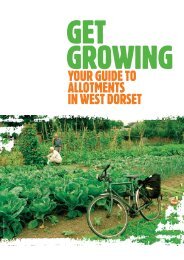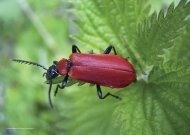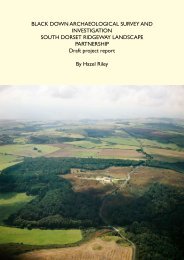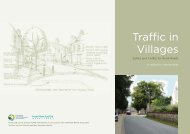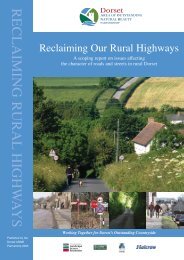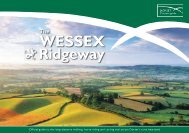Woodland Strategy 11.34 Mb - the Dorset AONB
Woodland Strategy 11.34 Mb - the Dorset AONB
Woodland Strategy 11.34 Mb - the Dorset AONB
You also want an ePaper? Increase the reach of your titles
YUMPU automatically turns print PDFs into web optimized ePapers that Google loves.
Section 7<br />
Appendix 2 -<br />
Description of Key Issues<br />
50<br />
Legislation<br />
The main Acts for protection of biodiversity in England and Wales are <strong>the</strong> Wildlife and<br />
Countryside Act 1981, <strong>the</strong> Countryside and Rights of Way Act 2000 and Planning Policy<br />
Statement 9 (PPS 9). However, <strong>the</strong>re is ano<strong>the</strong>r layer of legislation produced at a European<br />
level. These are European Union (EU) Directives which are produced to have effect at a<br />
national level as regulations. There are many such regulations which have an impact on<br />
environmental matters, <strong>the</strong> most important being <strong>the</strong> Conservation (Natural Habitats)<br />
Regulations 1994. Containing five Parts and four Schedules, <strong>the</strong> Regulations provide for<br />
<strong>the</strong> designation and protection of 'European sites', <strong>the</strong> protection of 'European Protected<br />
Species' (EPS), and <strong>the</strong> adaptation of planning and o<strong>the</strong>r controls for <strong>the</strong> protection of<br />
European Sites.<br />
Under <strong>the</strong> Regulations, competent authorities i.e. any Minister, government department,<br />
public body, or person holding public office, have a general duty, in <strong>the</strong> exercise of any of<br />
<strong>the</strong>ir functions, to have regard to <strong>the</strong> EC Habitats Directive.<br />
Climate Change<br />
Climate change and global warming occur naturally but over extremely long periods of time.<br />
The processes involved have been accelerated by <strong>the</strong> demands humans are putting on <strong>the</strong><br />
earth’s natural resources, including oil, coal, natural gas and woodland and forest<br />
deforestation.<br />
To try to redress this balance <strong>the</strong> Government is encouraging <strong>the</strong> use of ‘biomass’ to produce<br />
heat and power along with o<strong>the</strong>r measures to reduce carbon emissions and better utilise<br />
renewable energy resources such as solar, hydro wind.<br />
The trees, forests and woodlands of <strong>Dorset</strong> have a role to play in reducing <strong>the</strong> impact of<br />
climate change. The challenge is to protect what we have, and ensure we can adapt to <strong>the</strong><br />
new threats and opportunities that climate change will bring while still maintaining and<br />
expanding a sustainable forest and woodland resource.<br />
Landscape<br />
Trees and woodlands are a feature of many parts of <strong>the</strong> <strong>Dorset</strong> landscape. There has<br />
long been a social and cultural connection with trees and woodlands in <strong>the</strong> landscape with<br />
tremendous benefits in terms of influencing <strong>the</strong> general quality of life for local people, and<br />
underpinning a significant part of tourism industries<br />
Landscape is many things to many people. The landscape of <strong>Dorset</strong> as it is today has been<br />
shaped by thousands of years of human interaction with <strong>the</strong> environment. Geological<br />
formations and natural process created landforms and which have been shaped by humans<br />
into distinctive landscapes. Landscapes are valued by people for many different reasons.<br />
It provides habitats for wildlife, a cultural record of how our ancestors lived and utilised its<br />
resources and in many cases provides an economic resource, whe<strong>the</strong>r from farming or<br />
forestry, or by contributing to a sense of identity, well-being and enjoyment and attracting<br />
businesses and tourism.<br />
In recent years <strong>the</strong> assessment of landscape character has played an ever-increasing role in<br />
aiding decision making. Its role is to help ensure that development and change does not<br />
undermine but enhances what is valued or characteristic about any landscape, and is an<br />
important tool in planning and management for <strong>the</strong> future.<br />
Biodiversity<br />
Any land management system, or lack of one, will have an impact on tree and woodland<br />
biodiversity, whe<strong>the</strong>r it is intensive conifer forestry, coppice management, pollarding,<br />
continuous cover management, non/minimal intervention or left as natural reserves. The<br />
key to successful biodiversity management is identifying your objectives ad applying <strong>the</strong><br />
appropriate management practices.<br />
With any type of management protecting wildlife value and biodiversity is a key objective.<br />
There are many factors that influence <strong>the</strong> management of trees and woodland including<br />
personal objectives of <strong>the</strong> landowner, current and previous management practices, species<br />
present and <strong>the</strong>ir conservation value/status, economics and funding.<br />
• Identifying <strong>the</strong> appropriate sustainable management prescriptions for trees and<br />
woodlands can be a complex task with more than one ‘right’ answer. However, without a<br />
sustainable management plan it is almost impossible to achieve objectives. Identifying<br />
primary woodland use should not be undertaken without considering links to secondary<br />
woodland use. For example <strong>the</strong> primary use may be coppicing/timber production but<br />
secondary uses could include wildlife, shooting, recreation, education or a combination of<br />
<strong>the</strong>se and o<strong>the</strong>rs.<br />
Plantations on Ancient <strong>Woodland</strong> Sites (PAWS)<br />
PAWS are sites that have a long history (since 1600 at least) of woodland cover. They are<br />
ancient semi-natural woodlands on which <strong>the</strong> original, “native” woodland was ei<strong>the</strong>r<br />
enriched or cleared, and replaced by a plantation of ei<strong>the</strong>r native or exotic species. Between<br />
<strong>the</strong> 1930s and <strong>the</strong> early 1980s nearly 40% of ancient semi-natural woodlands were converted<br />
into plantations, most of which were of non-native coniferous species.



